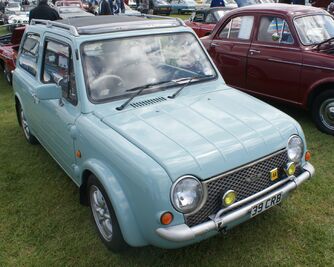
Nissan Pao
The Nissan Pao, first announced at the Tokyo Motor Show in October 1987, is a retro-styled automobile from Nissan Motors. It was available as a three-door hatchback with or without a textile sun roof ("canvas-top"), the canvas top being the most collectible. The Pao was one of three fashionable spinoffs of the K10 Micra — the Figaro and Be-1 being the other two. Like the Figaro, the Pao was sold without the Nissan name and only by reservation from January 15 through April 14, 1989; orders were served according to their date of placing. The Pao sold out in 3 months and remains a sought after and collectible car, with only about 51,657 made.
According to the article on Japanese Wikipedia, the name is a Chinese word describing a type of house used by nomads in Mongolia for assembly or meetings.
History[]
Part of Nissan's "Pike" series, it was designed as a retro fashionable city car in the mold of the Be-1. It included external door hinges like the original 1960s Austin Mini which had become fashionable in Japan, 'flap-up' windows like those of a Citroën 2CV, and a split rear tailgate of the first British hatchback car the Austin A40 Farina Countryman. The Be-1, Pao, Figaro, and S-Cargo were attempts to create cars with designs as desirable as those of Panasonic, Sony, and other personal electronics products.
The engine was the March/Micra's 1.0 L (987 cc) MA10S, coupled with a three-speed automatic transmission or a five-speed manual transmission, the manual being the more sought after. The engine produced 52 PS (38 kW; 51 hp) at 6,000 rpm and 7.6 kg·m (75 N·m; 55 lb·ft) at 3,600 rpm.
The chassis included rack and pinion steering, independent suspension with struts in front and 4-links and coil springs in back. Brakes were discs up front and drums in the rear. It has a clamshell hatch in back, meaning the glass section swings up and the bottom portion opens down to create a tailgate. The compact Pao requires just 4.4 m (14.4 ft) to turn and delivers up to 51 mpg (5.5 L/100 km) in the city and 79 mpg (3.4 L/100 km) at a steady 60 km/h (37 mph). The tires were of 155/SR12 format.
The designs of the Pike cars (excepting the Figaro) are usually credited to Naoki Sakai, who also worked for Olympus, where he brought back "the brushed aluminium look". Sakai also helped design Toyota's later WiLL cars, which echo the Pike series.
Specifications[]
Dimensions and weight[]
- Length: 3,740 mm (147.2 in)
- Width: 1,570 mm (61.8 in)
- Height: 1,475 mm (58.1 in) - 1,480 mm (58.3 in)
- Wheelbase: 2,300 mm (90.6 in)
- Front/rear tread: 1,365 mm (53.7 in)1,355 mm (53.3 in)
- Ground clearance: 165 mm (6.5 in)
- Min. turning circle: 4.40 m (14.5 ft)
- Seating capacity: 5 people
- Vehicle weight: 720 kg (1,587.3 lb) - 760 kg (1,675.5 lb)
- Gross vehicle weight (kg): 995 kg (2,193.6 lb) - 1,035 kg (2,281.8 lb)
Fuel consumption[]
- City: 5-speed 5.4 L/100 km (44 mpg-US); automatic 6.9 L/100 km (34 mpg-US)
- At steady 60 km/h (38 mph): 5-speed 3.4 L/100 km (69 mpg-US); automatic 4.3 L/100 km (55 mpg-US)
Engine[]
- Type: MA10S
- Water-cooled inline-4 cylinder
- Cylinder bore and stroke: 68.0 x 68.0 mm
- Total cubic displacement: 987 cc
- Compression ratio: 9.5:1
- Output (net): 52 PS (38 kW; 51 hp) at 6000 rpm
- Largest torque (net): 75 N·m (55 lb·ft) at 3600 rpm
- 1-bbl carburettor
- Fuel and tank capacity: unleaded regular, 40 L (2,441 cu in)
Body colors[]
- Aqua Gray (#FJ-0)
- Olive Gray (#DJ-0)
- Ivory (#EJ-I)
- Terracotta (#AJ-0)
Interior colors[]
- Ivory (#EJ-I)
- Black (#EJ-I)
Standard equipment[]
- Power steering and height adjustable driver's seat
- Electromagnetic glass hatch release
- Height-adjustable driver's seat
- Intermittent wiper
- Tensionless ELR seat belts (front seats),
- Radio (AM/FM, tape deck, electronic tuner)
- 2 rear loudspeakers
